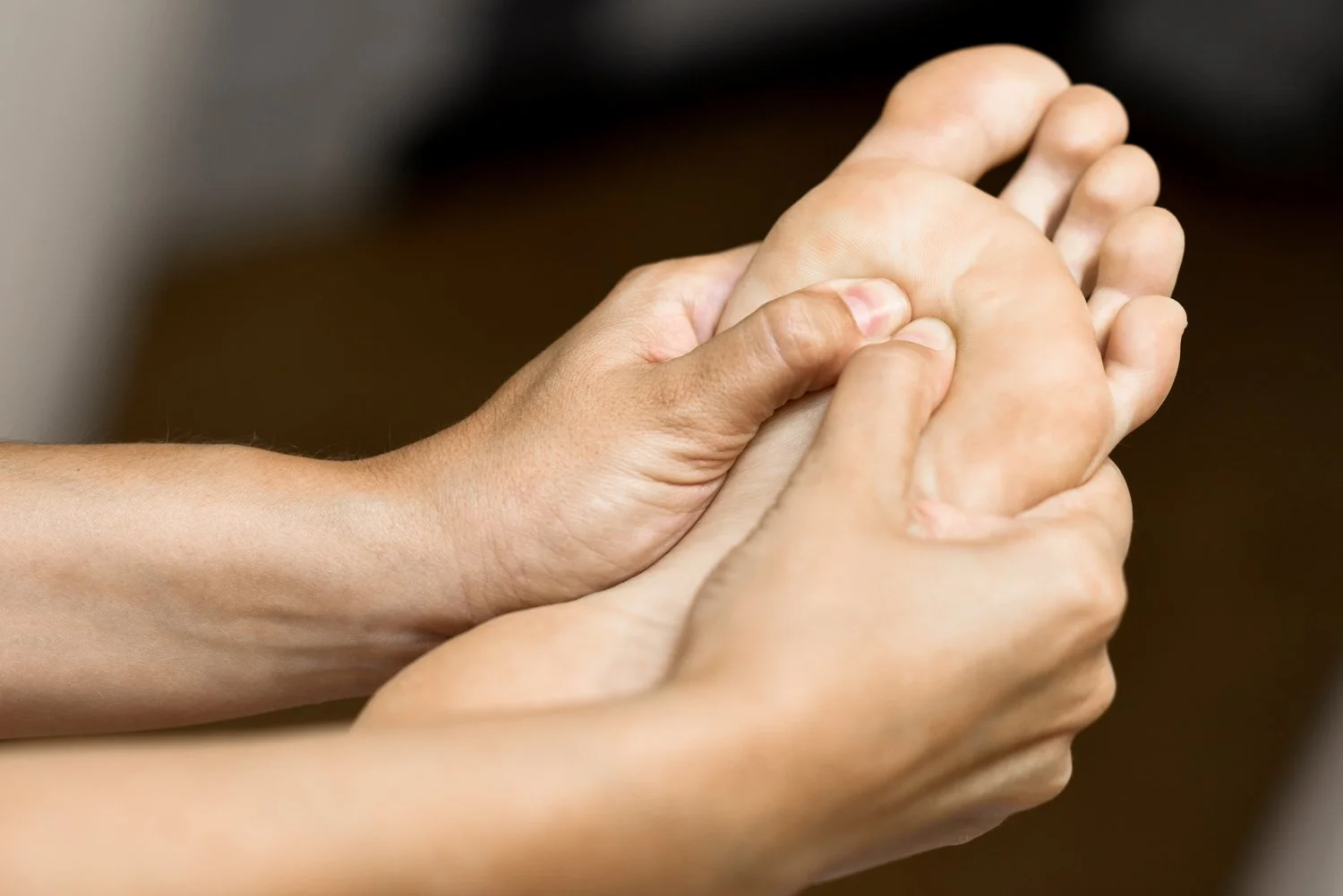Blogs
Foot Neuropathy: Innovative Solutions and Traditional Treatments
Foot neuropathy is a painful condition that can be difficult to manage.But thanks to modern technology and medical advancements, it doesn’t have to mean life in agony.
In this post, we’ll explore the various treatments for foot neuropathy—traditional approaches such as rest, physical therapy, medications and injections, and more innovative options like stem cell therapy and targeted nerve stimulation (TNS).
Find out whether one of these solutions may be right for you!So stop suffering needlessly and get informed on the available treatments: let’s start discussing Foot Neuropathy right now.

Diagnosis
A full medical history
During your appointment with the doctor, they will ask you about your medical history, such as your symptoms, lifestyle, drinking habits, exposure to toxins, and any family history of neurological diseases.
Neurological examination
During your medical evaluation, the doctor may assess your tendon reflexes, muscle strength and tone, ability to perceive specific sensations, as well as your posture and coordination.
Tests
Blood tests
Tests on blood samples can reveal the presence of vitamin inadequacies, the onset of diabetes, irregular immune responses, and other markers of diseases that could lead to condition peripheral neuropathy.
Analyzing Internal Structures
Employing imaging technologies like CT or MRI scans, medical professionals can identify the presence of herniated discs, nerve compression, tumors, or other irregularities in the blood vessels and bone structure.
Evaluating Nerve Performance
A specialized test called Electromyography (EMG) captures the electrical activity in your muscles, an important measure for detecting nerve damage. This test involves the insertion of a slim needle, known as an electrode, into the muscle, which then registers the electrical activity as your muscle contracts.
Your healthcare provider or an EMG technician will often conduct a nerve conduction study alongside the EMG. This involves applying flat electrodes on the skin and sending a low-intensity electric current to stimulate the nerves. The responses of your nerves to the electrical stimulation are then recorded.
Additional Nerve Performance Evaluations
These may encompass an autonomic reflex screen, a procedure that documents the performance of the autonomic nerve fibers, a sweat test that gauges your body’s capacity to perspire, and sensory tests that assess your sensitivity to touch, vibration, and temperature variations.
Investigating Nerve Tissue
This process involves extracting a tiny nerve fragment, usually a sensory nerve, to examine for irregularities.
Assessing Skin Tissue
In this procedure, your doctor removes a small segment of the skin to search for decreased nerve endings.
How is peripheral neuropathy treated, and is there a cure?

Medications
Various medications, including anticonvulsants or corticosteroids, may be recommended to address your specific symptoms. Your healthcare professional might also suggest antidepressants, anxiolytics (anti-anxiety drugs), and muscle relaxers like carisoprodol.
Physical Therapy
Physical therapy methods can help reduce pain and improve one’s range of motion. This treatment also includes exercises that help strengthen muscles weakened by nerve damage and stretching and massage techniques that can help reduce spasms.
Surgery
Surgery might be necessary to alleviate nerve pressure caused by factors like tumors if you suffer from neuropathies.
Devices and wearable equipment
Your healthcare provider can suggest braces, splints, or special shoes designed to reduce strain on affected areas. Additionally, you may be prescribed a TENS device, which helps relieve pain by sending electrical pulses through electrodes placed near your skin.
What are the possible complications or side effects of peripheral neuropathy treatments?
The most common side effects of treatment for foot neuropathy include increased sensitivity to light touch, increased pain, and decreased strength and coordination. In severe cases, these side effects can lead to more severe complications such as infection, nerve damage, or permanent disability. Other possible complications may include muscle spasms or numbness.
How do I take care of myself or manage symptoms of peripheral neuropathy?
The first step in taking care of yourself and managing symptoms of pain peripheral neuropathy is to be aware of your condition. Pay attention to signs and symptoms such as pain, numbness, tingling, or muscle weakness. Talk to your doctor if you experience any of these symptoms so they can recommend proper treatment for you.
Another important step is to make lifestyle changes that can help reduce symptoms. These may include quitting smoking, eating a balanced diet, maintaining a healthy weight, and exercising regularly. Additionally, try alternative treatments such as acupuncture or massage to relieve pain and discomfort.
Finally, there are home remedies that you can try for relief from neuropathy in your legs and feet. These remedies may include soaking your feet in warm water for 15 minutes, applying heat or cold packs to the affected area, taking over-the-counter pain medication, and using topical creams with capsaicin to temporarily relieve pain and discomfort.
With proper treatment and lifestyle changes, you can find relief from foot neuropathy symptoms and improve your quality of life. Talk to your doctor about the best treatment options for you and start taking steps towards a healthier, pain-free future today.
By following these tips, you can begin to manage your symptoms of foot neuropathy and find relief from pain and discomfort. Remember, always talk to your doctor before trying any remedies.
How can I reduce my risk of developing peripheral neuropathy or prevent it entirely?
Maintaining a healthy lifestyle is the best way to reduce your risk of developing peripheral neuropathy or prevent it entirely. Eating a balanced diet low in saturated fats, processed foods, and sugar can help improve overall nerve health. Regular physical activity can also help keep nerves active and promote proper nerve development.
FAQs About Treatment For Foot Neuropathy
What is foot neuropathy?
Foot neuropathy is a condition where nerves in the feet, often part of the peripheral nervous system, become damaged or dysfunctional. This can result in pain, numbness, weakness, or other disturbances in the feet.
What is the best foot treatment for neuropathy?
The best foot treatment for neuropathy will depend on the condition’s underlying cause.
Generally, treatment includes medications to reduce inflammation, pain and burning sensations, physical therapy and lifestyle changes such as increased exercise and a balanced, nutritious diet.
Protecting the feet from trauma or injury is important by wearing well-fitted shoes, padded socks and avoiding walking barefoot.
Can neuropathy in the feet be corrected?
Neuropathy in the feet can be corrected, depending on its cause and severity. In some cases, medications such as antidepressants or anticonvulsants can reduce discomfort and pain caused by neuropathy. In contrast, lifestyle changes such as increased exercise, improved diet, and proper foot care may help to improve nerve function.
What is the latest treatment for neuropathy in feet?
The latest treatments for neuropathy in feet include various options, depending on the source and severity of the condition.
These treatments may include medications such as antidepressants and anticonvulsants to reduce inflammation, pain, and burning sensations; physical therapy to help rehabilitate affected nerves; lifestyle changes such as increased exercise and proper nutrition; devices or wearable equipment; and podiatry and foot care to reduce the risk of future injury.
Surgery may be an option for severe cases.
How do doctors treat foot neuropathy?
Doctors typically treat foot neuropathy with various medications, physical therapy, lifestyle changes, devices or wearable equipment, podiatry, and foot care.
Medications may include antidepressants to reduce pain and burning sensations and anticonvulsants that can help improve nerve function.
Physical therapy can be used to help rehabilitate affected nerves. Lifestyle changes such as increased exercise and a balanced diet are important for improving overall health and reducing the risks of foot neuropathy.
Devices or wearable equipment may be recommended to reduce discomfort or pain caused by the condition. At the same time, podiatric care (foot care) can help protect the feet from further injury or trauma. In severe cases of neuropathy in feet, surgery may be an option.
How does a healthcare provider diagnose foot neuropathy?
A healthcare provider typically diagnoses foot neuropathy peripheral through a combination of a physical exam, a review of medical and family history, and tests such as nerve conduction studies, electromyography, or a nerve biopsy.
How effective are traditional treatments in managing neuropathic pain in foot neuropathy?
Effectiveness varies greatly from person to person. Some patients may find significant relief from traditional treatments, while others might still struggle with pain. It often takes trial and error to find the most effective treatment plan for each individual.
Conclusion
Regarding foot neuropathy, several solutions can help you reduce your discomfort.Relief is within reach, from innovative treatments such as stem cell therapy to more traditional remedies like massages and decompression therapy!
Of course, engaging with a trained medical professional is the most important factor in getting better from neuropathy.Finding a specialist you trust and can work with is essential for having the best outcomes from treatment.So don’t wait – book an appointment today and take the first step toward finding relief!
